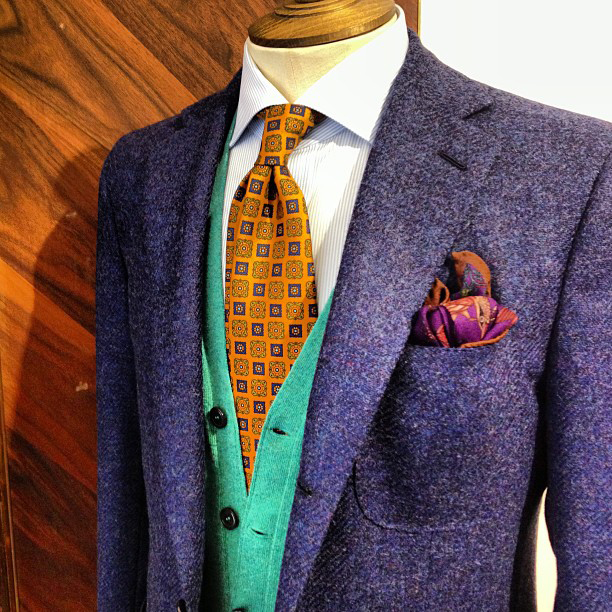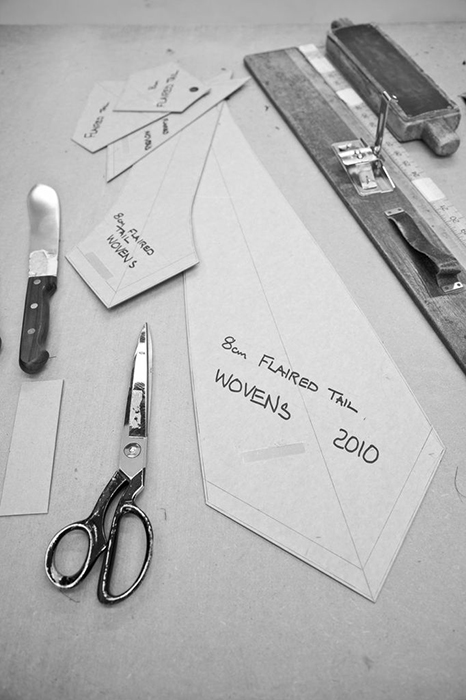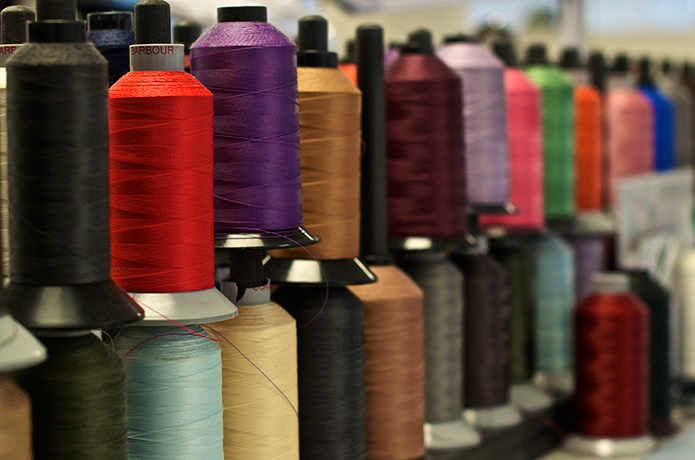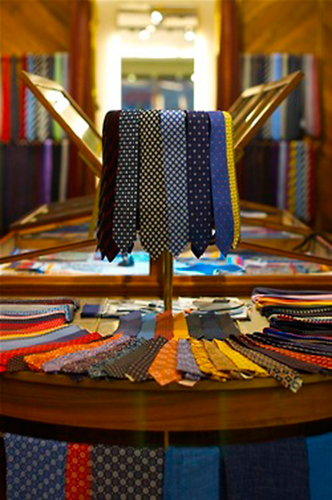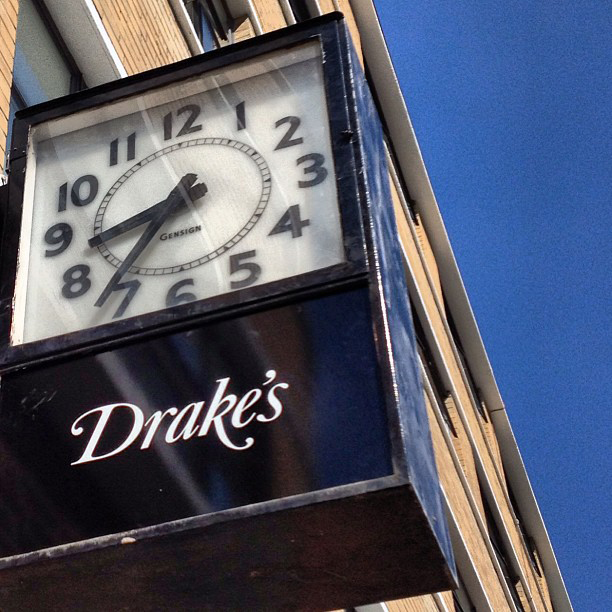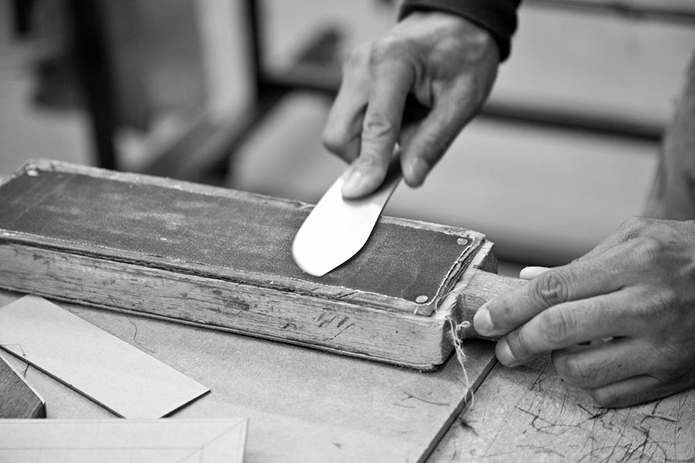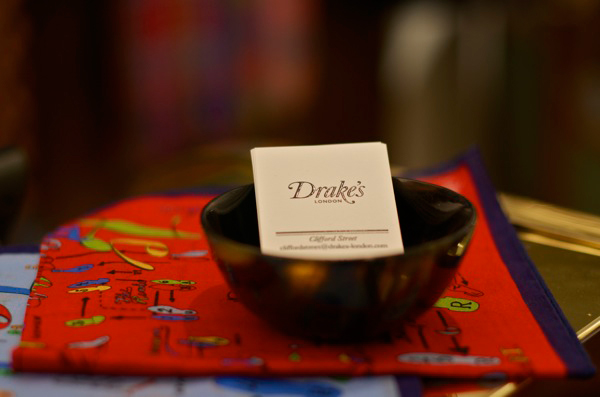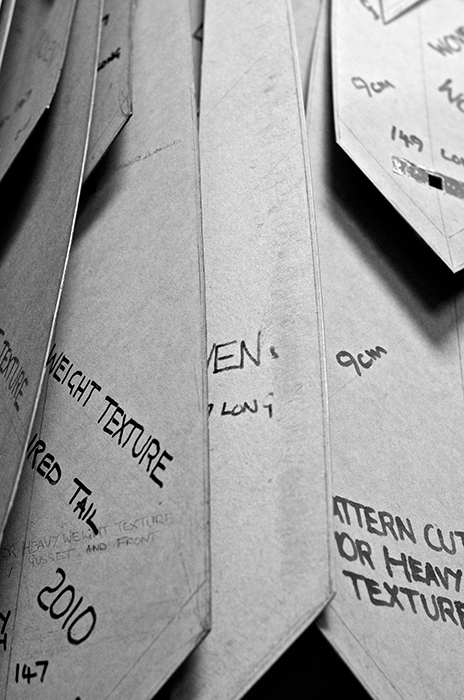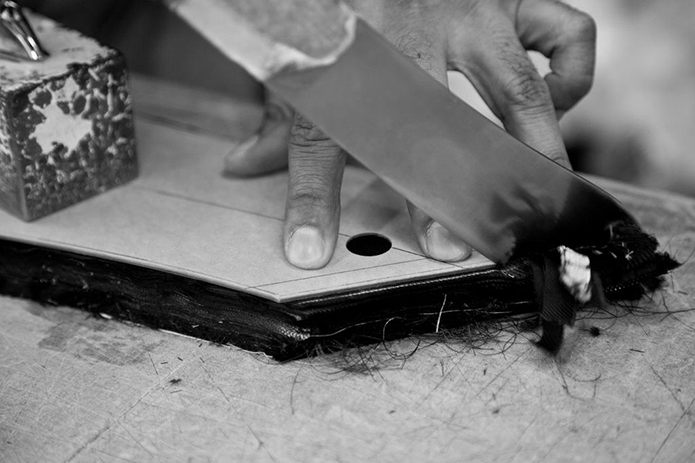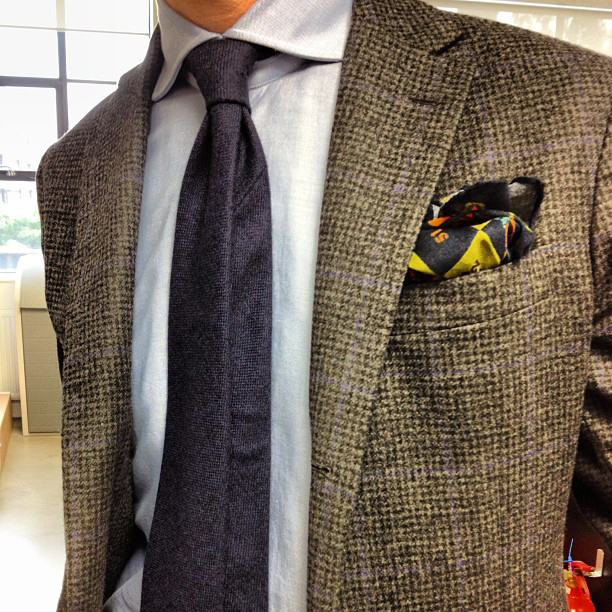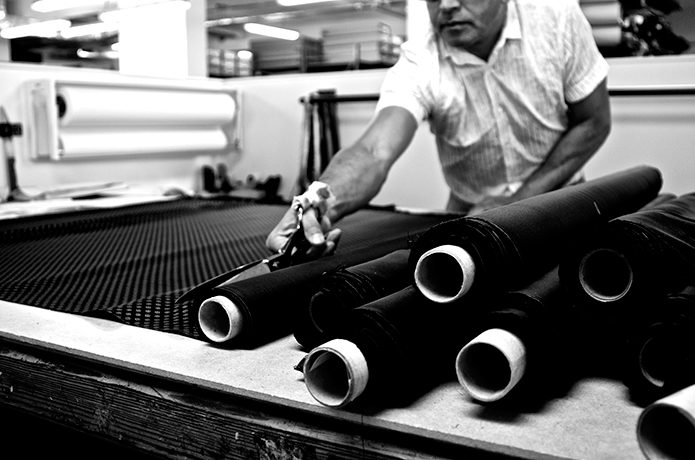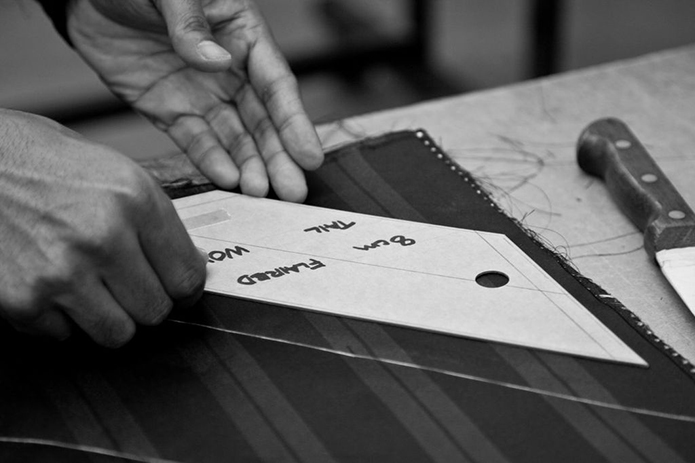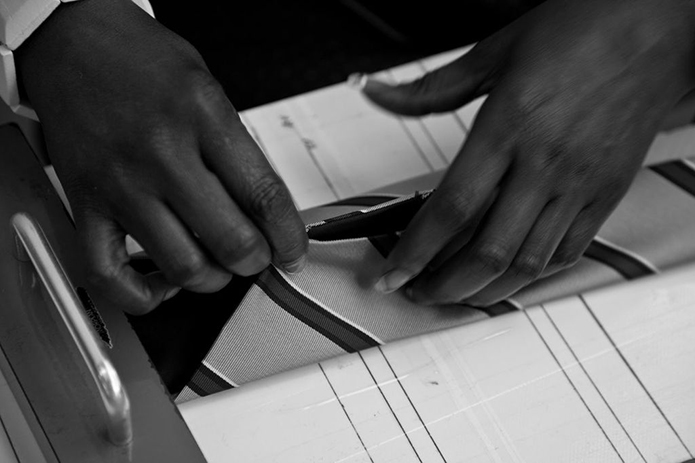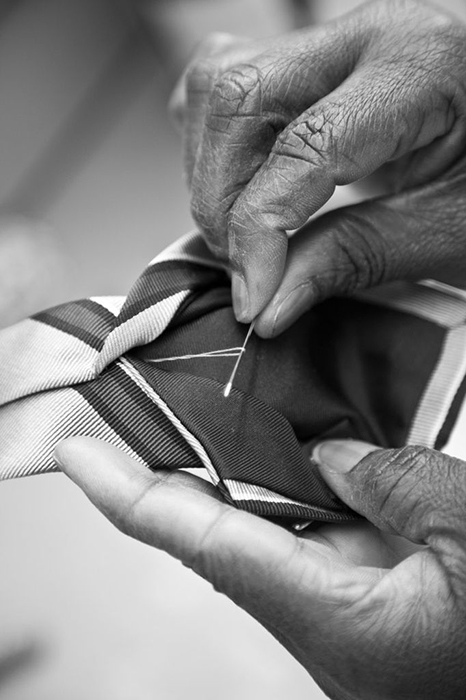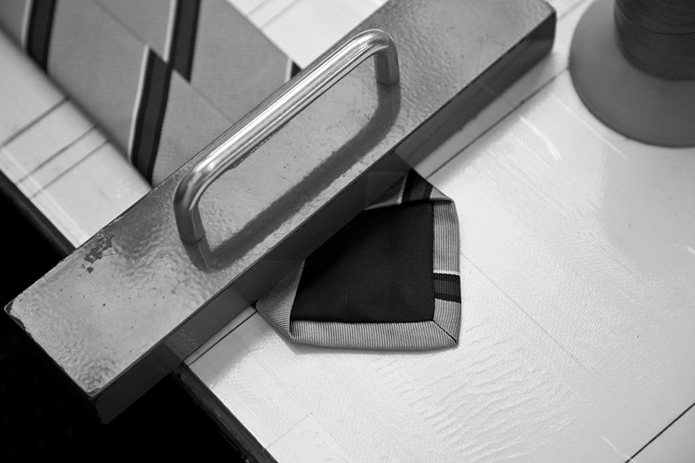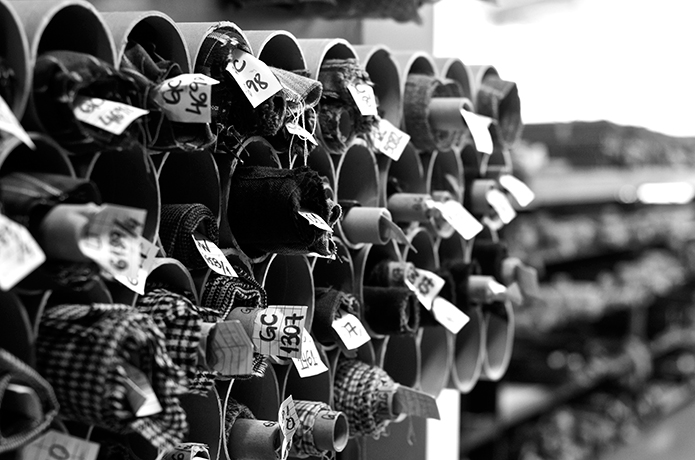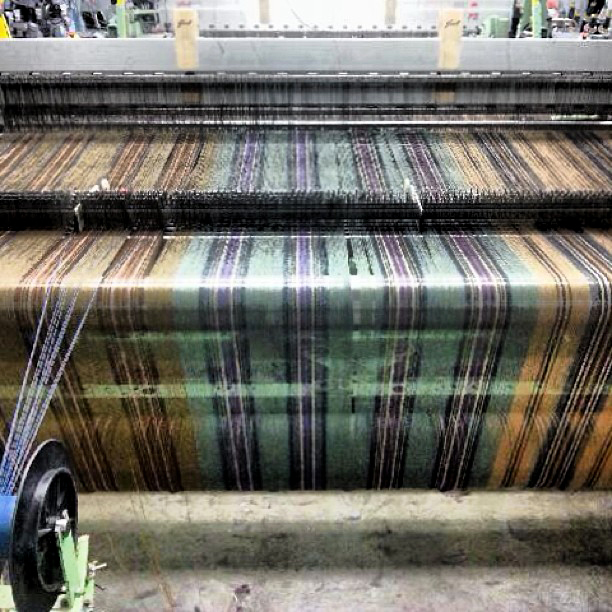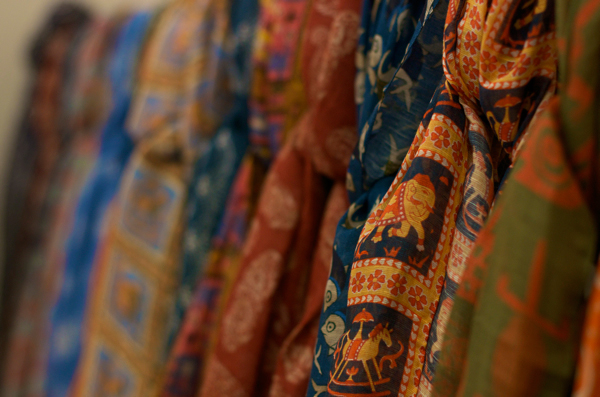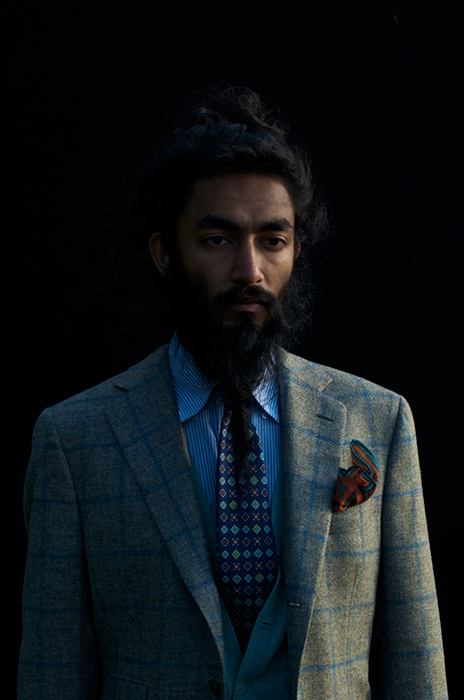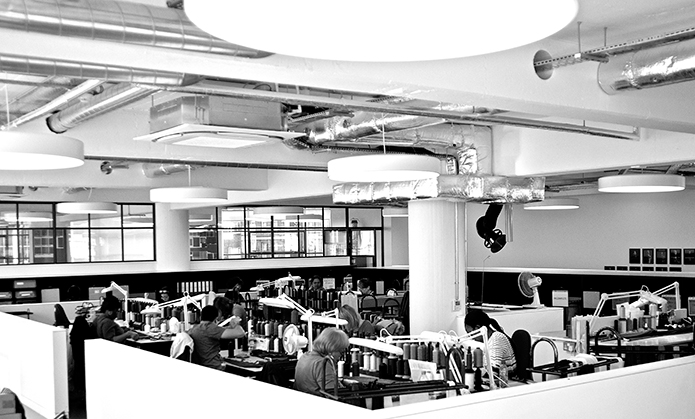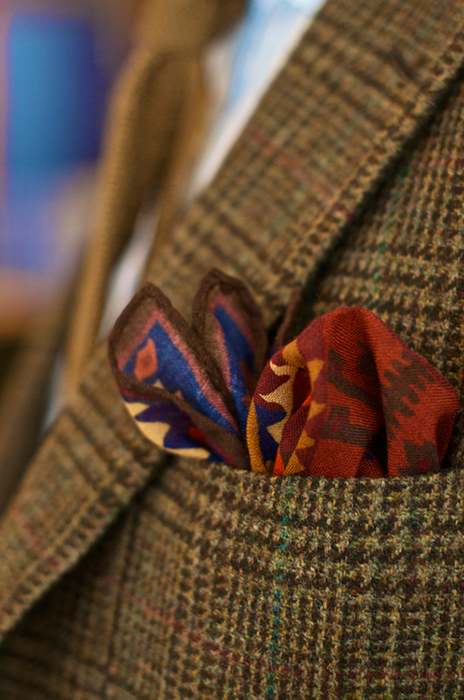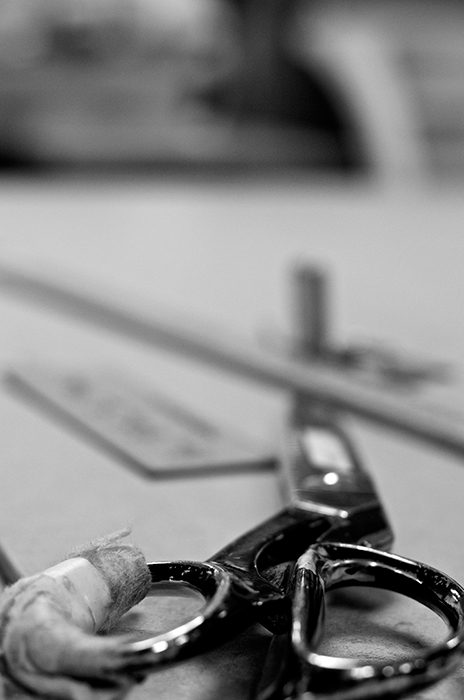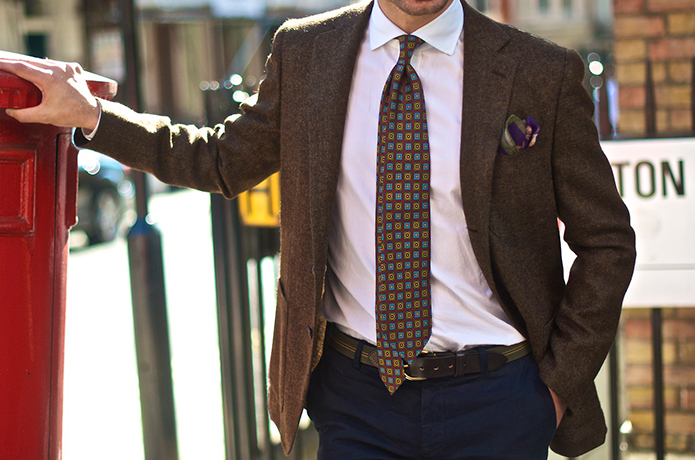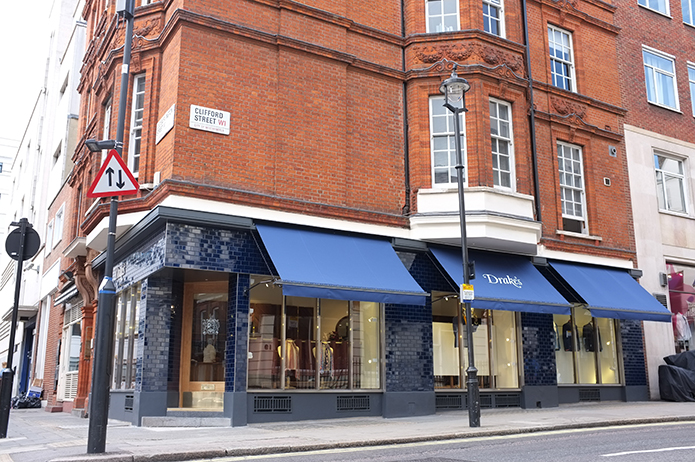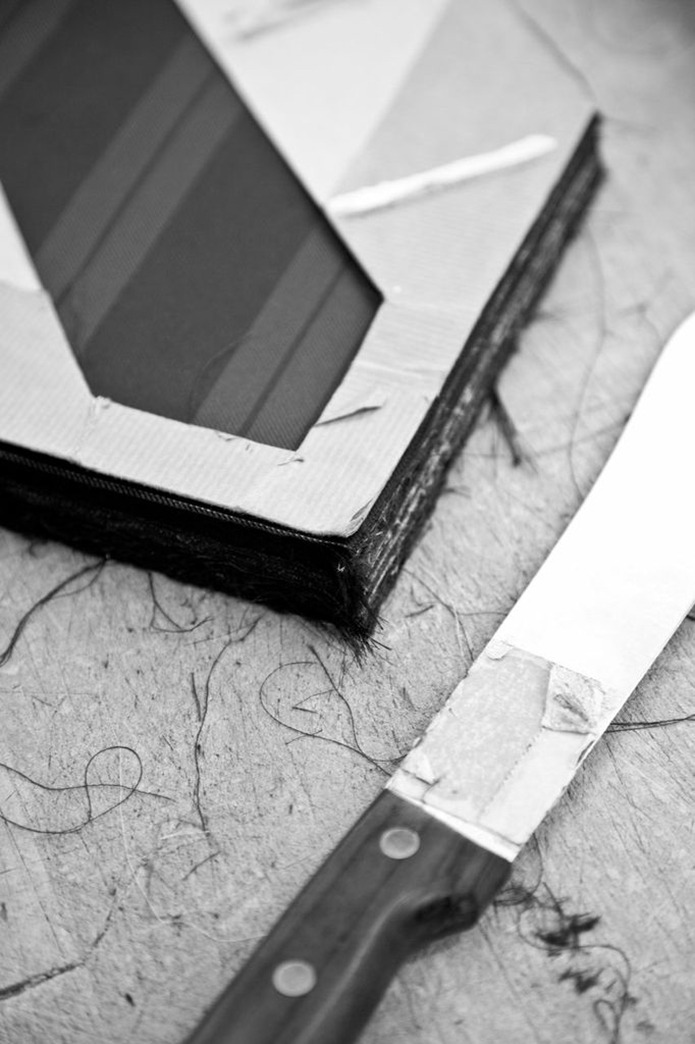
Drake’s London is the largest independent maker of handmade ties in England. Founded in 1977, by Michael Drake, the company has developed into a luxury clothing accessories brand, noted for its particular style – seamlessly combining ‘Britishness’ with an international twist – and is a truly exceptional British success story, winning prestigious accolades for design and export achievement.
Central to Michael Drake’s philosophy was the commendable commitment to British artisan textile manufacturing. From a small former Royal Mail depot in Clerkenwell, East London, Michael Drake and his experienced workforce of craftsmen and women dedicated themselves to creating England’s finest hand-cut, hand-sewn silk ties. The company has since evolved from its early days of men’s quality scarves, handmade ties and printed silk handkerchiefs to become the connoisseur’s accessory, haberdashery and accoutrements company.
A change in ownership came about in 2010 when Michael Drake retired and Michael Hill, Michael Drake’s previous understudy and lead designer, and Mark Cho, co-founder of The Armoury haberdashers in Hong Kong, jointly acquired Drake’s. Questions were asked at the time what direction the company would take and whether the commitment to British artisan manufacturing would continue. Michael Drake’s successor as MD, Michael Hill, kindly agreed to be interviewed to explain how, since the change in ownership, their commitment to British manufacturing is deeper than ever; how they founded their reputation; guides us through how a typical tie is made, and his thoughts on British tailoring and artisan textile manufacturing in general. I hope you enjoy the interview below.
Firstly, for those readers who aren’t aware of your background, please can you tell us about yourself and how you came to take over Michael Drake’s role as MD in 2010?
I have a long background associated with ties. My father owned a tie factory, and I spent a lot of time immersed in the tie business as a child. At one stage Hill & Drake items (that’s what Drake’s was called back then) were made in my father’s factory. There were lots of craftsmen and women in his factory and I’d often see six Volvo estates sitting on the drive in a row each full of balls of silk which had been picked up from silk mills. I literally grew up surrounded by mounds of silk. I would often accompany my father on visits to his factory on a Saturday when no-one else was there; that’s really where I first picked up the tie bug.
When I finished school I worked for Richard James tailor as I thought he was doing something special. He had a fledgling business at the time and was using ways of manufacturing that I had seen my father use, but reinterpreting them in a new way. I then went away to work in silk mills in Italy. When I came back I went to the London College of Fashion, although I was still working for Richard James part-time. After graduating I continued working for Richard James again, full-time, but by then I was designing as well.
After a few years Michael Drake called me to ask me to work for him. He knew how passionate I was about the tie industry and there was a mutual bond. I didn’t really have a title; Michael just introduced me to people as his ‘right-hand-man’. I had a good schooling working with Michael, designing and selling; it was fantastic experience. After 7 years, I realised I wanted to take the company on, and a great opportunity arose when Michael and his fellow partners decided they wanted to retire, as they didn’t have any successors in the family who wanted to continue things.
I have collaborated with my co-investor, Mark Cho, extensively in the past, as we produced ties for The Armoury in Hong Kong. Together we put together a package to acquire Drake’s. Michael stayed on for 6 months and we parted in a very friendly way. Here we are now.
When Michael Drake took the decision to sell Drake’s, how important was it to him to ensure that the new owners would share his original ethos, and how important was this to you too, in terms of future production, quality, brand direction etc?
It was very important to Michael Drake. The fact that I was his understudy for many years prior to his retirement has, I believe, provided the right continuity to the business which was so important at a critical stage in its evolution; we have even kept the same management team which has certainly helped.
Whilst Mark Cho has invested in Drake’s alongside me, I run the business, and Mark is basically a ‘sleeping partner’. Having said that, Mark Cho was fully endorsed by Michael Drake as an investor and it was clear that Mark was investing for all the right reasons – celebrating hand-crafted items around the world.
Michael really cared about the business; he created a great template and his philosophy runs deep. A lot of businesses get taken on for all the wrong reasons and get changed. If someone unknown to Michael had come in with a much higher offer, then I’m sure he’d have had to think about it, but I’m sure Michael would have felt pleased with his successors, knowing that we’d keep true to his original ethos and wouldn’t change things too much.
I viewed the opportunity with Drake’s as taking on a manufacturing business that had a great deal of potential to develop; develop in the right way of course. I didn’t think we were taking on a ‘brand’ as such. In my view the word ‘brand’ has been hijacked. Brand comes after the product – it’s all about the craftsmanship and the quality, the craftsmanship comes first, and the brand is secondary. Since taking over, we’ve certainly put our own take on things, but much of what we do is what Michael Drake would have done.
What makes a hand-made tie so special?
What makes a hand-made tie so special generally? I think people are returning to things that are being made by artisans. There is much more of a reverence for hand-made items these days than I can ever remember. Ties that are hand-made, ‘slipped’ by hand, have a softer quality, three dimensional-like, compared to machined ties which are very flat. A slipper must be able to feel how to slip the tie depending on the cloth. A machine will never know how much slack to leave in the slip stitch depending on the material being used, for example. It takes years of experience for our craftsmen and women to learn this skill. A hand-made tie will wear and give properly, and will be more comfortable. It’s something that’s ‘living’, made by someone that cares; not something that is churned out by a machine.
What makes Drake’s ties, specifically, so special? Well, it all starts with the cloth. Our focus is always on how can we make the cloth better. It’s never about the price. Then we look at how we’re making the tie; how the cloth is handled, how the different materials are worked. People don’t choose a Drake’s tie because we’re a brand; we don’t actually see ourselves as a brand. People come to us for their ties because they know how the product is made – by hand, where it’s made – in England, and that’s the most important thing for our customers, not about brand association. Personally, I’d far prefer to have one hand-made tie, than three machined ties for the same cost, although in many cases people are paying the same price for a machined tie from a well-known global brand, as it costs for one of our hand-made ties. I know which I would rather choose.
Could you guide us through the design and production process for one of your handmade silk ties?
All of our ties are cut by hand from the finest silks, using a different set of patterns for each quality of silk, such as heavy, woven or silk-printed. Each silk block is unrolled and checked for flaws prior to cutting.
We use generous blocks of silk which allows all three parts of the tie to be cut “fully on the bias” (at a 45-degree angle to the threads), which gives the silk a bit more give and stretch, so it will hang better and recover its shape more quickly. In theory each block of silk could make four ties if they cut “off the bias”, and some manufacturers do this, but the way we make them only allows for two to be made per block.
The tie is made from three silk tie parts: the blade (or front), the neck, and tail (or back). They are cut out from the block by a cutter using cardboard patterns and a very sharp knife to ensure the silk is cut cleanly. A small piece of cloth is also cut to make the loop called the “keeper” on the back of the blade where the tail is tucked. The blade, neck and tail are joined together, and a pure silk tipping (or partial lining) is sewn into the blade and tail. These can be self-tipped, where the same material is used for the lining as the outer fabric, or open-tipped, where a contrasting colour or weight of silk is used, but it is rigorously checked to ensure precision and smoothness of the jointure. Once joined together, the material is lightly pressed, but it’s essential that the three dimensional shape of the tie is retained, as this is what gives it character.
Next the tie is ready for the important art of hand slipping. The slipper carefully folds and pins an interlining (a strip of thicker material around which the silk is folded) into the blade tip until the correct shape has been achieved. The silk is then folded and pinned along the length, and a continuous length of silken thread, using a slightly curved needle and 40-gauge silk thread, is used to join the tie silk and interlining together. A classic slip stitch is used for this.
This is a very delicate operation, because the folded back seam has to remain in the centre of the tie, the edges of the interlining must be firmly held against the silk, but not too taut as wrinkles or tightness may appear, and it’s essential that the slipper doesn’t make a mistake by piercing the front of the tie. The keeper is sewn in at this stage as well.
Finally, a slip knot is left inside the fold at the tail to take up the stretch in the silk that occurs when it’s worn, ensuring that it will return to its original shape when hung (a tie should always be untied carefully and rolled before hanging). The knot is both functionally important as well as the hallmark of the handmade tie.
The final stages in the process are to sew in the Drake’s label and give the tie another very light press before it is ready to be put into its protective cover and boxed ready for delivery. In total the tie will have gone through eighteen different quality checks throughout its production.
You’ve made a commitment to support British, as well as Italian, textile manufacturing. Can you explain Michael Drake’s original ethos behind this decision, and how and why you are continuing to support this philosophy?
Michael Drake’s ethos was to build up a collection seamlessly incorporating Britishness with an international influence, with a subtly elegant ‘handwriting’, and he built up a great body of work in this style. I also share the same philosophy and want to stick to the ingredients that made Drake’s successful.
Choice of materials is of paramount importance to our business, and a great of time goes into selecting materials; I find the most enjoyable part of my role is sourcing materials. It is a very collaborative process between myself and the mills, and we work very hard to create something special; without our suppliers we would be nothing and they are very much part of the Drake’s community.
On the whole, suppliers are home-grown; we source cufflinks from silversmiths in Birmingham, Irish yarns from Donegal, Scottish cashmere, silks printed in Macclesfield and Suffolk woven silks. We have our own factory in Clerkenwell, employing an experienced workforce of craftsmen and women whose expertise lies in the central ethos of the company, the absolute attention to every detail in every stage of the manufacturing process. Whilst the majority of our suppliers are British, about 90% I’d say, we also have several suppliers in Como in Italy making, for example, exquisite grenadine and satin shirt and tie fabrics and panama hats; suppliers who are similarly artisanal in their approach.
We have some great long-standing relationships with our suppliers, many which date back to when the company was first established in the 1970s. Many of these suppliers are small, specialist suppliers who work in a very authentic way. One of our mills still uses a shuttle loom, which takes longer to weave but they produce an excellent material. Our silks are hand printed, which is more expensive and time-consuming, but you get cloth with real lustre. If you get cloth with the right softness then it makes the rest of the production process so much easier.
Do you find it a challenge to make the consumer realise that quality hand-crafted products are an investment, as they’re made to last and hold more value for money?
No, it’s increasingly not the case. Customers are looking to be more in touch with what they’re wearing, its provenance, and they place a lot of trust in where items come from. Of course, we’re up against large, global brands that outsource production to the Far East at a much lower cost than we can produce our goods, and that will always be a challenge. However, we can only control what we do and our focus is to build up integrity in our products. We’ve worked hard to build up a reputation for high quality, hand-crafted products, and we’re proud of that. In many ways, it’s the younger generation that are more interested in provenance; maybe it’s a case that they look back at the items that their father’s and grandfather’s generations used to buy with reverence, placing value on items that they will treasure and will hold onto. On the odd occasion a hand-made tie will need to be brought back to us to be repaired, and that’s a service that we happily provide; I think that’s the other aspect of buying hand-made items, as it much easier to have them repaired or altered by the same people that originally crafted them.
Drake’s ties are handmade in Clerkenwell, a stone’s throw away from the financial district of London. Do you feel that light industry still has a place in modern, urban centres?
I would like to think so, but of course, it’s very tough. Surely a modern urban centre would be better and richer for having light industry there! For us, it’s where our craftsmen and women are based; without them we’re nothing, so we simply have to make it work. It’s increasingly harder to survive in cities, but hopefully we’ll be strong enough to survive the pressure; it would be a terrible shame if we ever have to move, and something I don’t want to have to contemplate.
What do you think are the main contributing factors to how successful Drake’s has become?
Firstly, Michael Drake and the legacy that he left – that’s what we stand on. I think the fact that we make items from hand is also important. We’re a company that isn’t run by accountants; we celebrate the product and that takes central place in our thinking, not bottom line profit. We work very hard; Michael worked hard, I work hard – we’re an export business, and there’s a lot of people to see around the world! I like to think that everyone at Drake’s works very hard and we’re all pulling together, and there’s a huge amount of respect for the people that work in the business. Continuity has been important for us; two of my fellow Directors have been in the business for twenty years, and they’re able to pass on and spread the ethos, culture and company philosophy to new members of staff. We’re also not stuck in the past; we do things the right way, but we do develop new ideas; it has to be a slow evolution, but we are constantly keep in touch with new ideas and I think we have succeeded in doing that well.
What advice would you give to someone who wanted to launch their own brand of clothes or clothing accessories, like Michael Drake did back in the ‘70s?
There aren’t really any barriers to entry in this industry, so that certainly helps anyone starting out. My advice would include being very careful who you work with, don’t cut corners, and learn from well-run businesses; there are certain things that run through well-run businesses, subtle nuances of how things work, that’s very important to try and emulate. I think it can be a good idea to be a small cog in a large well-run business, to build knowledge and reputation early in your career. The industry is very connected, and anyone starting out would do well to remember that. Be careful not to work for a business that makes things the wrong way; and to focus on business that focuses on craftsmanship, even if that means working for a small company initially.
What do you think the future holds though for the British textile industry as a whole; will we see the trend continuing for companies to outsource manufacturing to Asia, or can you see there being a revival at some stage?
I’ve heard the ‘revival’ word being mentioned on-and-off since I was 18 years old, and that ‘Made in England’ would be making a come-back. I sincerely hope that is the case and I do get a sense that there is actually a resurgence now that is gaining momentum. I think for many businesses price will be a key factor, but we don’t place emphasis on price as our business isn’t built on that – the product always comes first for us – and so we don’t follow the whole cost-benefit analysis of outsourcing as it’s not important to us. I anticipate that the cost of outsourcing to the Far East will become more-and-more expensive as skills shortages become prevalent there, and it’s only a matter of time before inferior products become a greater problem.
It’s basically because of the confidence we have in the British textile industry that we acquired the century-old shirt-makers Rayner & Sturges in June 2013, as we’re so excited about the possibilities and we see a big opportunity to develop the business in the same manner as we’ve been able to develop Drake’s.
Can you provide any details on future projects? For instance, with the opening of your Clifford Street store, are we likely to now see further Drake’s stores opening up in Paris, Milan, Tokyo or New York?
The acquisition of Rayner & Sturges was very important to us, and it’s a great opportunity for us to develop our offering to complement Drake’s. We opened our store on Clifford Street in 2011, and a new factory and nice factory store on Haberdashers Street, so we’ve been quite busy.
We have re-launched our website as well. But to be honest, we don’t have a piece of paper that we map out exactly what our intentions are; we have plans and ideas and we take opportunities as and when they present themselves. We don’t say we have to be in Paris, Milan or New York. Yes, it would nice to be in Paris etc, but it’s not a major focus of ours. We have good relationships in Tokyo, so it would be nice to build something more there at some point.
Thanks to Michael Hill for taking time out of his busy schedule to answer our questions. All images © Drake’s London.

